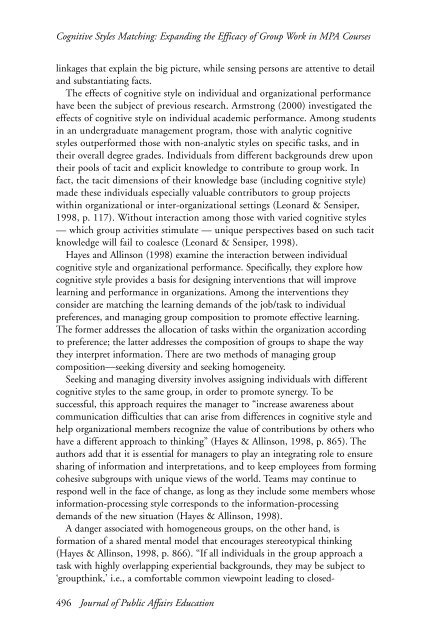JOURNAL OF PUBLIC AFFAIRS EDUCATION - National ...
JOURNAL OF PUBLIC AFFAIRS EDUCATION - National ...
JOURNAL OF PUBLIC AFFAIRS EDUCATION - National ...
Create successful ePaper yourself
Turn your PDF publications into a flip-book with our unique Google optimized e-Paper software.
Cognitive Styles Matching: Expanding the Efficacy of Group Work in MPA Courses<br />
linkages that explain the big picture, while sensing persons are attentive to detail<br />
and substantiating facts.<br />
The effects of cognitive style on individual and organizational performance<br />
have been the subject of previous research. Armstrong (2000) investigated the<br />
effects of cognitive style on individual academic performance. Among students<br />
in an undergraduate management program, those with analytic cognitive<br />
styles outperformed those with non-analytic styles on specific tasks, and in<br />
their overall degree grades. Individuals from different backgrounds drew upon<br />
their pools of tacit and explicit knowledge to contribute to group work. In<br />
fact, the tacit dimensions of their knowledge base (including cognitive style)<br />
made these individuals especially valuable contributors to group projects<br />
within organizational or inter-organizational settings (Leonard & Sensiper,<br />
1998, p. 117). Without interaction among those with varied cognitive styles<br />
— which group activities stimulate — unique perspectives based on such tacit<br />
knowledge will fail to coalesce (Leonard & Sensiper, 1998).<br />
Hayes and Allinson (1998) examine the interaction between individual<br />
cognitive style and organizational performance. Specifically, they explore how<br />
cognitive style provides a basis for designing interventions that will improve<br />
learning and performance in organizations. Among the interventions they<br />
consider are matching the learning demands of the job/task to individual<br />
preferences, and managing group composition to promote effective learning.<br />
The former addresses the allocation of tasks within the organization according<br />
to preference; the latter addresses the composition of groups to shape the way<br />
they interpret information. There are two methods of managing group<br />
composition—seeking diversity and seeking homogeneity.<br />
Seeking and managing diversity involves assigning individuals with different<br />
cognitive styles to the same group, in order to promote synergy. To be<br />
successful, this approach requires the manager to “increase awareness about<br />
communication difficulties that can arise from differences in cognitive style and<br />
help organizational members recognize the value of contributions by others who<br />
have a different approach to thinking” (Hayes & Allinson, 1998, p. 865). The<br />
authors add that it is essential for managers to play an integrating role to ensure<br />
sharing of information and interpretations, and to keep employees from forming<br />
cohesive subgroups with unique views of the world. Teams may continue to<br />
respond well in the face of change, as long as they include some members whose<br />
information-processing style corresponds to the information-processing<br />
demands of the new situation (Hayes & Allinson, 1998).<br />
A danger associated with homogeneous groups, on the other hand, is<br />
formation of a shared mental model that encourages stereotypical thinking<br />
(Hayes & Allinson, 1998, p. 866). “If all individuals in the group approach a<br />
task with highly overlapping experiential backgrounds, they may be subject to<br />
‘groupthink,’ i.e., a comfortable common viewpoint leading to closed-<br />
496 Journal of Public Affairs Education

















